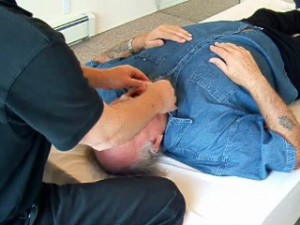- earache
- tinnitus / tinnitis
- jaw joint pain on one side
- orofacial pain
- bite deviations
- inability to open the jaws fully
- bruxism / teeth grinding
- headaches
- neck pain
- spine pain
- postural changes
To discuss each of these symptoms, we will have to discuss a little bit of anatomy.
This simplified explanation obviously does not discuss the various muscles of jaw movement individually — but you’ll get a basic, clear understanding.
The jaw joints — the TMJs or temporo-mandibular joints — exist just in front of the ears. The excessive compression caused by chronically tight jaw muscles causes pain in just that location, which triggers muscular contractions in the muscles surrounding the ears. The net result — muscle and joint pain.
Tinnitus is “ringing in the ears.” Compression of the TMJs induces or increases tinnitus. One explanation is that the muscles of the middle ears, which attach to and tune the resonant frequency of the three sound-transmitting bones of the middle ears (hammer, anvil and stapes), reflexively tighten with jaw tension. You may have noticed that, while you yawn, your hearing fades. That indicates the reflexive connection.
As I said, earlier, most dental trauma occurs on one side. The trauma reflex triggers muscular contractions — and pain — on that side.
Orofacial PainThe trauma reflex triggers muscular contractions — and pain — in the muscles of the face.
Uneven muscular contractions alter jaw movement and bite.
Since those muscles are constantly held reflexively in contraction, they limit how far the jaws can open.
Jaw clenching and grinding are the behaviors of tight jaw muscles. Nocturnal bruxism may be associated with speech and emotion during dreaming. Just as rapid eye movement (REM) during dreaming is a recognized phenomenon, the muscles of speech also move during dream-speech. Combined with hightened jaw tension, such movements could account for nocturnal bruxism. This is a point of reasoning, not of empirical studies — but it does make sense.
One set of muscles of biting — the temporalis muscles — connect from the sides of the jaws to the sides of the head, near and behind the temples. When tight, these muscles compress the bones of the head, producing headache at the sides of the head. Other muscles, the suboccipital muscles that connect the rear of the head to the neck, reflexively tighten with mouth-opening movements and may become conditioned to a heightened state of tension that goes with the heightened effort needed to open jaws held tight by muscles of biting. Tension headaches at the forehead and in the eyes result from such tension.
See On Headaches
The jaws have connections both above and below. The muscles below go to the neck. When tight muscles above the jaws displace movement from center, the muscles below tighten reflexively, pulling the head, which weighs about twelve pounds, off-center, causing muscle fatigue and pain in the neck.
When the weight of the head gets displaced off-center, the muscles of the spine tighten as part of the counter-balancing act. Fatigue and pain result.
Patterns of reflexive tension thus to all the way from the jaws down the spine and throughout the trunk, changing posture and movement.
See video on TMD/TMJ Syndrome Self-Relief.
See exercises based upon The Whole-body Yawn that Relieve TMD/TMJ Syndrome — CLICK HERE
next article: Causes of TMJ Syndrome
directory of TMJ articles: Treatment for TMJ Syndrome

